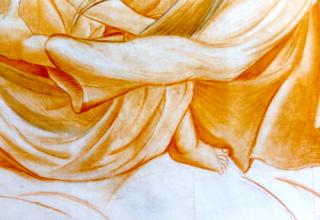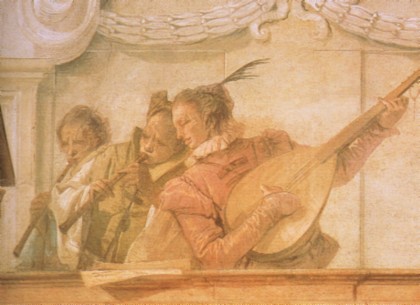I was starting another of what I call "fresco fragments" today, reproductions of master fresco. The purpose is to develop my skills, but also to educate the public as to the subtle beauty and appeal of this medium. Few people will get to see the real master frescos of the world. For myself, the photos of the frescos only came alive when I started to put the same colors on fresh lime plaster.So! This obscure detail by Tiepolo, from "Banquet of Cleopatra" caught my eye. I liked it but thought, with my building skills, that I would reproduce it at one third scale, to make it easier to manage. This was a mistake, the brush strokes were far to small and eventually I had to scratch (scrape off the putty before it fully set) the piece.
But now I like this piece, I am going to try at its 48"w x36"h actual size. I will use a concrete mesh, but will reinforce it with three strips of 2" wide galvanized channel steel, bolted through the mesh with stainless steel. My question is how would this typically be sectioned out or would it be painted in one day? Also the colors seem very simple, but are there any special tips or observations? I think the faces were hurried byt Tiepolo, this is minor detail of the piece, I may take a little more time to detail the faces. If anyone would like a higher resolution jpeg, please let me know and I will email it. Maybe we could all learn from one piece! All attempting the same from all parts of the world.
<I think the faces were
<hurried by Tiepolo,
<this is minor detail of
<the piece, I may take a
<little more time to
<detail the faces.I do not think that Tiepolo actually "hurried" those faces, as you noted "this is a minor detail". If we take a look at the work of Michelangelo, the same "hurrying" in the secondary compositions (second, third, forth, etc. plains) would be present. The reason for that is that the human eye does not see all the details in focus at the same time, so the artist should reflect this factor along with the rules of perspective and foreshortening in the developing of the composition. If we look at any classic easel painting we will find that the faces and detail in the secondary plains are not as developed as the faces on the front plain. It is often overlooked in contemporary murals which results in the "cartoonish" (in ref. to movie) look of the mural.
Since you are painting this section as a separate panel as a study and not a copy, it is a good idea to "focus" the image a little. Just do not get carried away, it will change the look and feel of the painting.
Ilia Anossov
http://www.truefresco.com/anossov
http://www.truefresco.com/workshop
< My question is how would
< this typically be sectioned
< out or would it be painted
< in one day? Also the colors
< seem very simple, but are
< there any special tips or
< observations? You should be able to complete this copy at the size of 36x48 in a day (I would) other ways you will have to go through some elaborate cutting.
You can create the rough edge, like you wrote in the forums that should cut about 2+ sq. feet of the total footage and give you more time to work a detail and size would not look that scary.
Then if plaster is done properly and I am sure with you it will! be it should give you about 8 - 12 hours of painting time - that is plenty.
I noticed that fresco works faster for me than acrylic, can not paint over so take it slow but work exact - you know "slow and sturdy wins the race".
Prepare the full scale cartoon with shading and "everything" This will teach your hand to memorize the piece and you will gain confidence. Below is the sample of my cartoon for the Albuquerque Fresco. This sample should show how far the cartoon should be developed.

Use tracing paper for transfer nothing thicker!!! before laying tracings over get a small piece of the tracing paper about one inch square and lay it on the plaster if it will get wet or stick to the plaster - wait a few min and try again until the piece will be falling off without sucking any moisture.
Lay the pounced tracings over and dust with charcoal! not with red pigment. It is a delicate, in color, piece and red will scream out and drag no matter what!
Use wet color underpaint in terra verde, then get light umber with a bit of yellow ochre wet wet and work out slightly the columns and swags and walls.
Check the colour mixes by dipping the brush in and pulling it out - should run quick then stop and give you three last drops (i do not know which brushes you use but should work).
Squeeze the brush between fingers slightly, if not will live blotches also it is fresco - the color that is left should give you about three long strokes twenty times more that fully loaded and dripping acrylic brush.
When done take raw umber and work shadows - cold ones several times warm ones lightly. Then take a burnt umber wet and work out the flesh and warm shadows of figures and fore ground shadows (that thing on the bottom).
Then get the rosy mix wet red oxide - very little pigment and glaze the wall live the swags and that curly thingy in upper left corner along!
Get some yellow ochre may drop a bit of umber and drop of lime (white) wet, lay done some veins and stuff for marble wall, that curly thingy live along, touch the swags. Pick up the shadows here ore there with raw umber
Move to figures terra verde and a bit of yellow ochre for the jacket on the left dude red ochre on the right one wet wet get sienna wet wet and work the bottom. Touch up the shadows with raw umber and work the hair.
Now you are at the midday - thicker colors - when the brush is pulled out of the color - does not run but still will gives you three drops at the end but slow. Do not forget to squeeze the darn thing (brush). Work high lights and shirts.
Work out the people and the details with the variations of the above color, put some accents keep working until you are sick of it - at some point you will suddenly see that it miraculously started to look good - sometimes even very good! Get some detail on the swags pick up some accents on the wall
You are at the end of the day! Wet color back - glaze the whole thing with thin color. Get some thick color and pick the final detail and contrasts - "sorta" outline. Get some highlight accents with thick fat white (lime) - you are done! It will tell you when she's got enough of you.
*wet or wet wet - applies to color consistency.
Ilia Anossov
http://www.truefresco.com/workshop
LAST EDITED ON 08-Mar-01 AT 11:46 AM (PST)>I was starting another of what
>I call "fresco fragments" today,
>reproductions of master fresco. The
>purpose is to develop my
>skills, but also to educate
>the public as to the
>subtle beauty and appeal of
>this medium. Few people will
>get to see the real
>master frescos of the world.
>For myself, the photos of
>the frescos only came alive
>when I started to put
>the same colors on fresh
>lime plaster.
Well, put Gary!
The dedication of the truefresco.com is to change that (Few people will get to see the real master frescos of the world). I believe that our contributions to this forums and truefresco.com is rasing the awareness of this Beautiful Art Form through making the comprehensive information on fresco easily available from anywhere in the world which lays the foundation for much needed Fresco Society in America and the World.
Ilia Anossov
http://www.truefresco.com/anossov
http://www.truefresco.com/workshop

